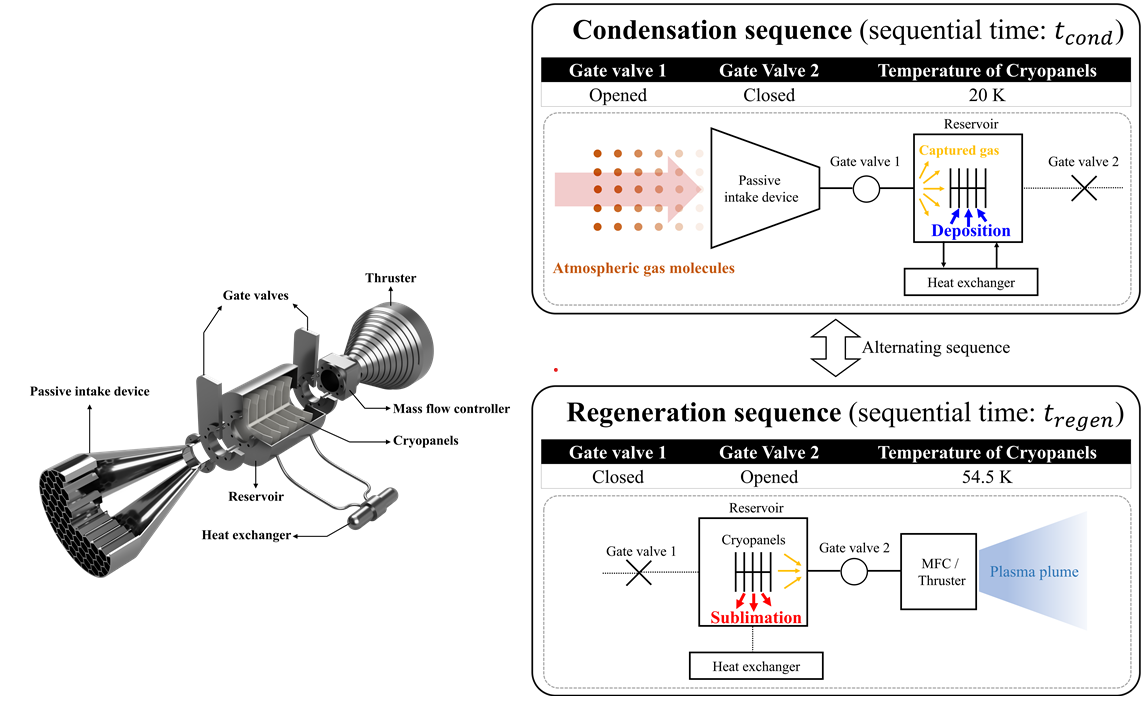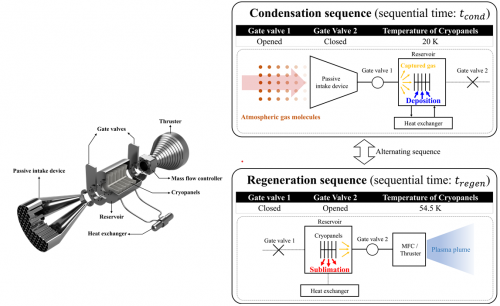Major research outcome
- Ph.D. Candidate Geonwoong Moon and Prof. Eunji Jun, Cryogenic active intake device for atmosphere-breathing electric propulsion in very-low-Earth-orbit
- 관리자 |
- 2024-06-28 17:30:21|
- 249
- 2024-06-28 17:30:21|
As the mission altitude of a satellite decreases, the ground observation resolution and communication efficiency can be improved. Additionally, the shorter revisit period is advantageous for surveillance and reconnaissance operations. Consequently, the very low Earth orbit (VLEO), at altitudes below approximately 450 km, is garnering attention as a future domain of space technology. However, the residual rarefied atmosphere in VLEO induces drag force, significantly shortening the satellite's mission lifespan. Although propellant-efficient space propulsion systems, including plasma-based electric propulsion, can be equipped to compensate for atmospheric drag and perform orbit maneuvers, they require a high mass of onboard propellant for long-term missions.
Recently, the concept of an atmosphere-breathing electric propulsion (ABEP) system has been proposed and is under active research. This system captures the residual atmosphere in VLEO and uses it as propellant for electric propulsion. ABEP is expected to facilitate long-term orbit maintenance without requiring propellant loading during the launch phase, making it a promising future technology. However, the development of a feasible ABEP system necessitates an efficient particle intake device. Preliminary studies have investigated the design of passive particle intakes that collect atmospheric particles using the satellite’s orbital speed of up to 7.8 km/s, employing funnel-like rigid structures. Nevertheless, further performance improvements are considered necessary to ensure the formation of discharge pressure for ionizing the propellant and providing an adequate propellant flow rate for sufficient thrust generation.
In the KAIST Non-equilibrium Gas and Plasma Dynamics Laboratory (KNGPDL, advisor: Prof. Eunji Jun) of the Department of Aerospace Engineering, the concept of an active intake device based on cryogenic technology has been devised and simulated to enhance the performance of passive intakes. The cryocondensation-regeneration active intake device (CRAID) utilizes the principle of gas-to-solid phase transition of atmospheric constituents at cryogenic temperatures around 20 K. CRAID operates by storing the collected atmosphere through a passive intake in a solid state using cryogenic panels, subsequently sublimating and regenerating it into high-pressure gas to be used as propellant. The concept and operational principle of CRAID are illustrated in Figure 1. The research team designed the CRAID geometry and applied it to the Direct Simulation Monte Carlo (DSMC) method with a phase change model to predict the intake performance. Computational simulations demonstrated that CRAID can exhibit over 100 times higher compression performance compared to conventional passive intakes, while being capable of supplying a sufficient propellant flow rate for complete drag compensation. Since cryogenic cooling technologies have been demonstrated at Technology Readiness Level (TRL) 9 in spacecraft, further development of the CRAID system could enhance the feasibility of ABEP.
This work has been published in the international journal 'Aerospace Science and Technology' (IF: 5.6, JCR top 7.4% in Aerospace Engineering). First author: Geonwoong Moon, Ph.D. candidate.
Title: Design and operational concept of a cryogenic active intake device for atmosphere-breathing electric propulsion
https://doi.org/10.1016/j.ast.2024.109300

그림: Design components of CRAID (left: conceptual image, right: operational principles).
Recently, the concept of an atmosphere-breathing electric propulsion (ABEP) system has been proposed and is under active research. This system captures the residual atmosphere in VLEO and uses it as propellant for electric propulsion. ABEP is expected to facilitate long-term orbit maintenance without requiring propellant loading during the launch phase, making it a promising future technology. However, the development of a feasible ABEP system necessitates an efficient particle intake device. Preliminary studies have investigated the design of passive particle intakes that collect atmospheric particles using the satellite’s orbital speed of up to 7.8 km/s, employing funnel-like rigid structures. Nevertheless, further performance improvements are considered necessary to ensure the formation of discharge pressure for ionizing the propellant and providing an adequate propellant flow rate for sufficient thrust generation.
In the KAIST Non-equilibrium Gas and Plasma Dynamics Laboratory (KNGPDL, advisor: Prof. Eunji Jun) of the Department of Aerospace Engineering, the concept of an active intake device based on cryogenic technology has been devised and simulated to enhance the performance of passive intakes. The cryocondensation-regeneration active intake device (CRAID) utilizes the principle of gas-to-solid phase transition of atmospheric constituents at cryogenic temperatures around 20 K. CRAID operates by storing the collected atmosphere through a passive intake in a solid state using cryogenic panels, subsequently sublimating and regenerating it into high-pressure gas to be used as propellant. The concept and operational principle of CRAID are illustrated in Figure 1. The research team designed the CRAID geometry and applied it to the Direct Simulation Monte Carlo (DSMC) method with a phase change model to predict the intake performance. Computational simulations demonstrated that CRAID can exhibit over 100 times higher compression performance compared to conventional passive intakes, while being capable of supplying a sufficient propellant flow rate for complete drag compensation. Since cryogenic cooling technologies have been demonstrated at Technology Readiness Level (TRL) 9 in spacecraft, further development of the CRAID system could enhance the feasibility of ABEP.
This work has been published in the international journal 'Aerospace Science and Technology' (IF: 5.6, JCR top 7.4% in Aerospace Engineering). First author: Geonwoong Moon, Ph.D. candidate.
Title: Design and operational concept of a cryogenic active intake device for atmosphere-breathing electric propulsion
https://doi.org/10.1016/j.ast.2024.109300

그림: Design components of CRAID (left: conceptual image, right: operational principles).
| 첨부파일 |
|---|


